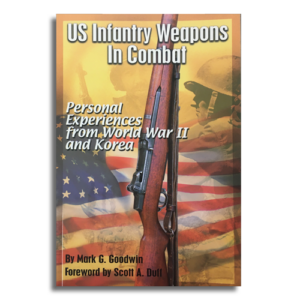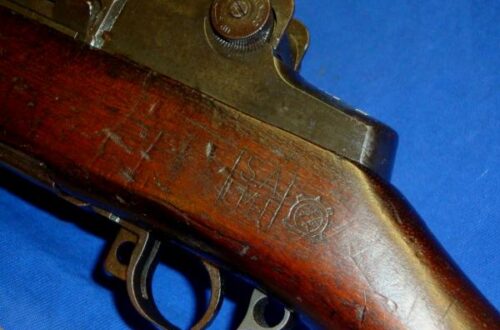“US Infantry Weapons in Combat” – Personal Experiences from World War II and Korea
The first thing that the reader must know about this book is that it is a gun book. It is not simply war stories, but is a series of interviews with soldiers and Marines specifically relating their experiences with the US infantry weapons in combat during World War II and in the Korean War. We decided to include both wars as basically both saw the same weapons used. As I first read the manuscript I was fascinated by the dramatically differing opinions. One man loved the M1 rifle and hated the M1 carbine while the next loved the M1 carbine and hated the M1 rifle. One thought that the Garand was too heavy and that the carbine was light and handy. The next thought that the carbine didn’t have enough stopping power and he would only carry a Garand. Based upon his personal experiences each man had his own opinion on the weapons that he had used during these wars and relates those observations to the reader.
The author first gave me a copy of the draft manuscript while we were at a gun show in eastern Pennsylvania. After a five-hour drive home from the show on Sunday and after unloading the truck, I had the opportunity to sit down in my easy chair to read a few sections of the manuscript. When I finished the last interview I realized that it was 1:00 AM and that I had been reading for hours! Once I began, I could not put this book down. You have been warned.
 What the men interviewed had to say about US infantry weapons fascinated me. So much of what we collectors think we know about the use of US infantry weapons in combat has been derived from two sources: movies and books. Some movies, like “Band of Brothers” are very accurate, others are not. Even though “Saving Private Ryan” was a wonderful movie, who can forget the fictitious quick-change scopes on the M1903 sniper rifle? The general history books of these wars rarely contain the in-depth details of infantry weapons that would be of interest to collectors. The stories about US infantry weapons contained in this book are the real hands-on experiences of the men who actually used them for their intended purposes.
What the men interviewed had to say about US infantry weapons fascinated me. So much of what we collectors think we know about the use of US infantry weapons in combat has been derived from two sources: movies and books. Some movies, like “Band of Brothers” are very accurate, others are not. Even though “Saving Private Ryan” was a wonderful movie, who can forget the fictitious quick-change scopes on the M1903 sniper rifle? The general history books of these wars rarely contain the in-depth details of infantry weapons that would be of interest to collectors. The stories about US infantry weapons contained in this book are the real hands-on experiences of the men who actually used them for their intended purposes.
Like the author and many other collectors in our age group, my interest in US infantry weapons of World War II and Korea began with watching movies like “Sands of Iwo Jima”. In the late 1950s and early 1960s I spent hour upon hour leafing through my father’s Korean War era Guidebook for Marines. Then in October of 1962 the television show “Combat” debuted. My Dad and I never missed episode. I was hooked on Garands, carbines, Thompson submachine guns, BARs, and .45 pistols! I knew that when I grew up I would own some of those weapons.
I bought my first GI .45 in 1981 and my first M1 Garand in 1985. Thus began my collecting of US infantry weapons of World War II and Korea. As my enthusiasm for collecting these arms grew, so did my study of the history of these wars. The natural progression then moved to the individual men who carried these weapons.
Because my Father had been a Marine during the Korean War, I started collecting Marines Corps uniforms and 782 gear. When in 1992 I learned that my future father-in-law, Thomas Shoen, Jr., had been a paratrooper in World War II I had to have an M1A1 carbine, jump boots, and a M1942 jump suit. In conversations with collectors I have found that many of us collect the firearms that we do because our dad, grandfathers, or uncles carried them in World War II and Korea. With that motivation it quickly becomes a personal quest to collect these artifacts.
Often times, upon acquiring a new model of martial arm, the collector develops a greater curiosity of that weapon that goes far beyond simply owning an example. He wants to learn how to disassemble, inspect and reassemble it. He wants to know what those numbers stamped on the parts mean. He may also choose to develop proficiency in firing it. But what does he know about that weapons use in combat? Like many of you I know the mechanics and collectible aspects of these arms. But even though I had written several books on collecting and maintaining these weapons, I knew little about their actual performance in combat. Through the interviews published in Mark’s book, collectors and shooters of World War II and Korea US infantry weapons now have an insight into the combat usage of these arms in the words of the men who used them.
The opinions of the individual interviewees may differ, and sometimes greatly, but it is their personal experiences that they lived, recalled and related to the author. Mark Goodwin has provided a great service by sharing those interviews in print. I hope that when you sit down to begin reading this book that you are as enthralled as I was and cannot put it down.
Our next Blog post will be an interview with Darrell “Shifty” Powers of The Band of Brothers. To read the Shifty Powers interview and 64 more fascinating stories go to our Bookstore and order “US Infantry Weapons in Combat – Personal Experiences from World War II and Korea.”
By Mark G. Goodwin
Foreword by Scott A. Duff
To receive a special 15% discounted price for “US Infantry Weapons in Combat” use code USI15 at check out.



